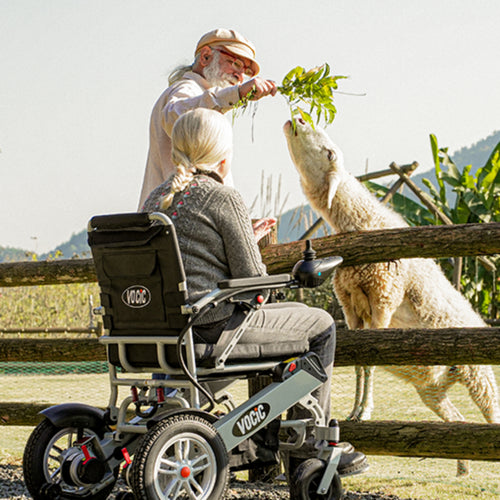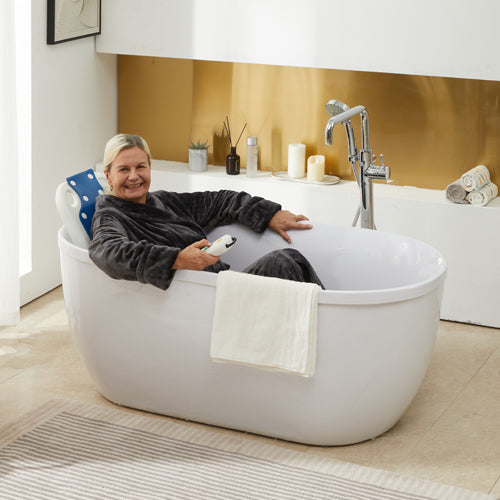Have you thought about the weight of a mobility scooter? Whether you are considering purchasing a mobility scooter for yourself or for a loved one, knowing the typical weight of these devices will help you make an informed decision.
The weight of a mobility scooter can vary depending on factors such as size, design, and materials. On average, most mobility scooters weigh between 100 and 220 pounds.
Lightweight folding mobility scooter can be as light as 70 pounds, making them easier to transport and store, while heavier models can weigh 400 pounds or more, providing greater stability and weight capacity.
We'll take an in-depth look at the factors that contribute to the weight of a mobility scooter, how weight affects use and portability, and tips for choosing a mobility scooter that meets your specific needs and preferences.
Understanding Mobility Scooter Weight

Lugging a mobility scooter that is too heavy feels like dragging a boulder up a hill. Let's take a look at why weight matters and what factors play a role in determining the weight of these mobility scooters.
1. Importance of Mobility Scooter Weight
The weight of a mobility scooter can greatly affect its usability and convenience for individuals seeking mobility assistance. Portability is an important consideration - lightweight mobility scooters are easy to transport, whether in a car or on public transportation.
For users with limited physical strength, a heavy mobility scooter may present challenges when lifting or maneuvering the device.
The needs of the user can also have an impact. For those with active lifestyles who enjoy excursions or traveling, lightweight mobility scooters can be a lifestyle changer, allowing them the freedom to explore without any restrictions.
Additionally, the weight of a scooter can affect its maneuverability indoors or in tight spaces, which can affect the overall comfort of the user.
2. Factors Affecting Mobility Scooter Weight
Several factors contribute to the overall weight of a mobility scooter.
Battery Size: Larger batteries mean more weight for extended travel ranges.
Frame Material: Steel frames are heavier but durable, while aluminum frames offer lighter options.
Motor Power: Powerful motors add weight for better performance.
Suspension System: Enhanced comfort with suspension systems increases scooter weight.
Accessories: Additional features like lights or baskets contribute to scooter weight.
Tire Type: Pneumatic tires offer better traction but add weight compared to solid tires.
User Weight Capacity: Scooters built for higher weight capacities are heavier.
Foldable Design: Foldable scooters may be heavier due to mechanisms for portability.
Understanding these factors aids in selecting a suitable mobility scooter while considering weight constraints for transport and storage.
Average Weight of Mobility Scooters

The weight of a mobility scooter is a key factor to focus on when considering the purchase of a mobility scooter. Let's delve into the world of mobility scooters and explore the average weight of different categories of mobility scooters.
1. Lightweight Mobility Scooters
Lightweight mobility scooters are designed with portability in mind, offering convenience for users who may need to transport their scooters frequently. These scooters typically weigh between 75 to 100 pounds.
For instance, the popular "TravelScoot" model weighs approximately 35 pounds, making it incredibly lightweight and easy to handle for everyday use.
2. Mid-Weight Mobility Scooters
Mid-weight mobility scooters strike a balance between portability and additional features. These scooters weigh between 100 to 150 pounds on average.
The "Drive Medical Spitfire EX2" falls into this category, weighing around 110 pounds. This range provides sturdy construction without compromising maneuverability.
3. Heavy-Duty Mobility Scooters
Heavy-duty mobility scooters are built for durability and stability, often catering to users who require higher weight capacities or intend to use their scooters on varied terrains. These scooters can weigh between 150 to 200 pounds.
The "Pride Mobility Wrangler" exemplifies a heavy-duty option, weighing approximately 195 pounds. Despite their heavier build, these scooters offer robust performance and enhanced comfort for extended use.
To navigate the wide variety of mobility scooters available, it's important to understand the weight differences between the various models.
Whether you choose a light, medium, or heavy mobility scooter, choosing the right weight category will help you with the rest of your driving experience.
Importance of Choosing the Right Weight Mobility Scooter
Next, let's dive into how choosing the right weight mobility scooter affects maneuverability, portability, and user considerations.
1. Impact on Maneuverability and Portability
The weight of a mobility scooter directly affects its maneuverability and the user's ease of transportation.
Lighter mobility scooters are typically more maneuverable, allowing them to effortlessly navigate through tight spaces, crowded areas, or around obstacles.
Heavier mobility scooters may present maneuvering challenges, especially in tight spaces or around sharp turns.
In terms of portability, lighter mobility scooters are easier to lift and transport, both in and out of vehicles and around the home. Mobility scooters that are too heavy will be a challenge for users without readily available assistance or with limited upper body strength.
2. User Considerations for Weight Selection
User Considerations When Choosing the Weight of a Mobility Scooter:
Portability Needs: Assess how often the scooter will need to be transported and opt for a weight that is manageable for lifting or loading.
Storage Space: Evaluate available storage space at home or in a vehicle to accommodate the scooter's weight and dimensions when not in use.
Terrain: Determine the typical terrain the scooter will be used on, as heavier-duty models may be necessary for rough or uneven surfaces.
User Weight: Factor in the weight of the primary user and any additional cargo to ensure the scooter's weight capacity meets their needs.
Budget: Consider the cost implications of lighter-weight scooters, as they may come at a premium compared to heavier models.
Accessories: Take into account any accessories or attachments that will be added to the scooter, as they can contribute to the overall weight and affect maneuverability.
By considering these factors, users can select a mobility scooter weight that best suits their individual needs and preferences, ensuring a comfortable and convenient experience.
Tips for Handling Mobility Scooter Weight
Navigating the weight of a mobility scooter can be a significant consideration for users. Here are some practical tips to handle mobility scooter weight effectively.
1. Lifting and Transporting Techniques
When it comes to lifting and transporting a mobility scooter, it's crucial to prioritize safety to avoid any strain or injury. Here are some guidelines to help you handle this task with ease:
Get a Proper Grip: Ensure you have a secure grip on the scooter using the designated handles or sturdy parts to lift it safely.
Use Assistance, if needed: If the mobility scooter is too heavy for you to lift alone, don't hesitate to ask for help from a friend or family member to prevent any injuries.
Utilize Ramps and Lifts: Invest in portable ramps or lifts for your vehicle to easily load and unload the scooter without the need for heavy lifting.
Consider Lightweight Models: If lifting the scooter is a concern, opt for lightweight models that are easier to handle and transport.
While learning how to handle the weight of a mobility scooter, you can also pay attention to the 6 safety tips for operating a mobility scooter, so that you can be more secure and safe when using a mobility scooter.
2. Storage Solutions for Heavy Mobility Scooters
For users with heavier mobility scooters, finding suitable storage solutions is essential for convenience and accessibility. Here are some suggestions to help you store your mobility scooter effectively:
Garage or Shed Storage: If you have a garage or shed, designate a specific area to store your mobility scooter safely when not in use.
Wall-Mounted Racks: Consider installing wall-mounted racks or hooks to hang your scooter, keeping it off the ground and maximizing floor space.
Folding Options: Explore folding mobility scooters that can be collapsed for compact storage, ideal for smaller living spaces.
Outdoor Covers: Invest in weatherproof covers to protect your mobility scooter if you need to store it outside, ensuring it remains in optimal condition.
By following these lifting and storage tips, handling the weight of your mobility scooter can become a more manageable task, enhancing your overall mobility experience.
Conclusion
After exploring the various factors that contribute to the weight of a mobility scooter, we have found that the weight of these devices can vary greatly depending on a number of aspects such as size, battery type, materials, and additional features. The weight of a mobility scooter is an important factor to consider before making a purchase, as it can affect portability, maneuverability, and the overall user experience.
Whether choosing a lighter, travel-friendly mobility scooter or a sturdier, more feature-rich scooter, users can give more thought to their specific needs when choosing a mobility scooter that fits their lifestyle.
Whether they choose a lighter and more suitable scooter for travel, or a sturdier and more versatile scooter, users can consider more of their specific needs when choosing a scooter that suits their lifestyle. You can check out a series of means of transportation on VOCIC, such as folding walker, transport chair, bath chair, etc., to help more people choose the transportation tool that best suits them.
Key Takeaways
- Mobility scooter weight can range from 50 lbs to over 200 lbs, based on various factors.
- Lightweight scooters offer easier portability and storage options for users with mobility needs.
- Heavier scooters may provide more stability and durability, ideal for outdoor terrains and longer distances.
- Battery type and size significantly impact the overall weight of a mobility scooter.
- Material choices, such as aluminum or steel, affect the scooter's weight and durability.
- Additional features like suspensions, seating options, and storage compartments can increase the scooter's weight but enhance user comfort and convenience.
In conclusion, understanding the weight of a mobility scooter is essential to choosing a model that meets the lifestyle and mobility requirements of the user.
By understanding the factors that influence the weight of a mobility scooter, users can make informed choices that will enhance their independence and quality of life.
Related reading: 5 different types of mobility scooters







